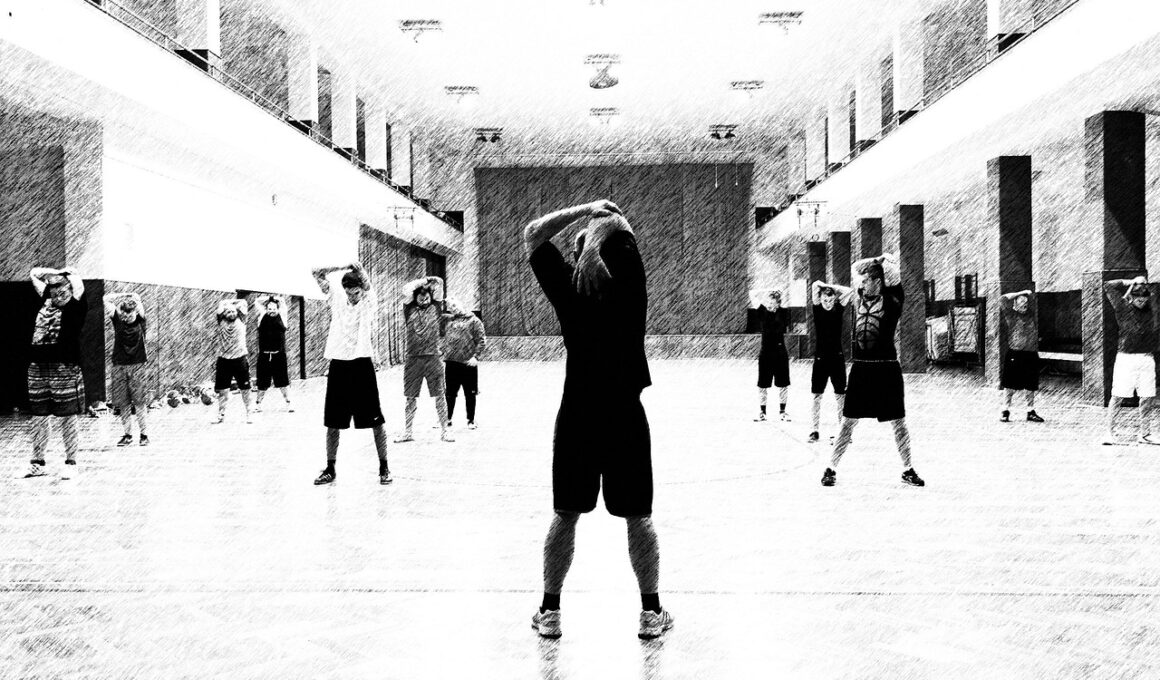Plyometric Warm-Ups: Preparing Your Body for High-Intensity Workouts
Plyometric warm-ups play a crucial role in preparing the body for intense workouts, particularly when engaging in plyometric exercises. These activities involve explosive movements that require strength, speed, and agility, making proper preparation essential. The primary goal of a warm-up is to increase blood flow to the muscles, elevate the heart rate, and prepare the nervous system. This preparation helps enhance performance and reduce injury risk. A dynamic warm-up routine tailored for plyometric training consists of movements that closely mimic the upcoming exercises. Common warm-up activities include high knees, butt kicks, and lateral lunges. Engaging in these activities will activate the major muscle groups involved in plyometric training while also improving range of motion. Moreover, warm-ups can also help in enhancing coordination, which is vital for performing jumps and explosive movements effectively. Incorporating plyometric drills into your warm-up routine prepares your body both physically and mentally. It sets the stage for a successful workout session that allows you to maximize your performance and achieve your fitness goals.
The Importance of Dynamic Stretching
Dynamic stretching is an essential component of any effective warm-up for plyometrics. Unlike static stretching, which involves holding a stretch for an extended period, dynamic stretching incorporates movement and ensures muscles are activated appropriately. This type of stretching not only increases blood flow to the muscles but also encourages flexibility, which is vital for explosive movements. Recommended dynamic stretches before a plyometric workout include walking lunges, arm circles, and leg swings. These movements target specific muscle groups and prepare them for the upcoming demands of plyometric training. Incorporating a variety of dynamic stretches can also help improve overall performance by increasing coordination and agility. Engaging in dynamic warm-ups can reduce muscle tightness and enhance the range of motion. As a result, you’ll be able to perform explosive movements with greater ease and efficiency. Strengthening is as important as flexibility, so balance is key. Ultimately, a well-structured warm-up routine that includes dynamic stretching will set you up for a successful plyometric workout and contribute to long-term fitness achievements.
An effective plyometric warm-up should not only include dynamic stretching; you should also prioritize sport-specific movements. These exercises should mimic the high-intensity activities that will be executed during your plyometric regimen. Incorporating such movements prepares the body for its specific demands, enabling better performance. For instance, if you plan to perform box jumps, incorporating a few lower-intensity jumps or skips will help your muscles adapt. Additionally, performing bounding exercises before plunging into more complex plyometric movements can enhance your ability to control your body and transfer force. Another recommended activity is the use of mini-bands to facilitate resistance during lateral movements, which can help build strength and power in the hip area. As your warm-up progresses, increasingly engage the muscles’ fast-twitch fibers to prepare them for the explosive nature of plyometrics. Furthermore, introducing skill drills focused on balance and coordination can ensure proper movement patterns. Ultimately, these integrated warm-up strategies can lead to improved exercise efficiency and overall performance in all subsequent high-intensity workouts.
Progressive Intensity Warm-Ups
When preparing for plyometric training, incorporating a progressive intensity approach during your warm-up can further enhance effectiveness. Begin with lower-impact movements and gradually introduce higher-intensity jumps or sprints. This method allows your body to adjust progressively to the increased physical demands placed on it. Starting with basic activities such as brisk walking or gentle joint rotations can help you ease into your routine. Once your muscles feel warm, include more dynamic exercises like skipping or hopping to raise your heart rate further. Gradually introduce agility drills designed to engage your fast-twitch muscle fibers. Incorporating low-intensity bounding or jumping movements will help your muscles adapt to more explosive actions. As you progress through the warm-up, focus on maintaining proper form and technique to establish good movement patterns. Additionally, ensure that your body is mentally prepared for the high-intensity workout ahead. This approach not only minimizes the risk of injury but also maximizes your performance potential. Remember that investing time in a progressive intensity warm-up translates into better results and improved overall athletic performance.
Incorporating proper breathing techniques during your plyometric warm-up can have significant effects on your performance. As you engage in dynamic movements, focusing on your breathing will help stabilize your core and maintain control throughout your exercises. Diaphragmatic breathing, where you breathe deeply into your abdomen rather than shallowly into your chest, enables optimal oxygen flow to your muscles. This practice enhances endurance, which is vital for sustaining high-intensity workouts. During explosive movements, also consider exhaling forcefully at the most challenging point of the exercise. This technique can help improve stability and overall power output. Moreover, being mindful of your breathing can assist in reducing anxiety or nervousness before a challenging workout session. As a bonus, establishing a rhythm with your breathing can enhance coordination, especially during fast-paced plyometric movements. Failure to prioritize breathing can lead to fatigue or compromised performance during your workout. Finally, consider integrating breathing exercises into your warm-up to reinforce its importance. Being conscious of your breath contributes significantly to enhancing your overall exercise experience.
Cooldown Essentials After Plyometric Training
Cooling down after a plyometric workout is just as crucial as a proper warm-up. A proper cooldown helps facilitate recovery by gradually lowering the heart rate and returning your body to a resting state. After completing high-intensity exercises, engage in lower-intensity movements such as walking or gentle jogging for five to ten minutes. This allows your body to flush out metabolic waste products from the muscles. Next, consider incorporating static stretching into your cooldown routine. Focus on gently stretching the major muscle groups used during your plyometric training, as this can help improve flexibility and relieve muscle tightness. Pay special attention to the quadriceps, hamstrings, calves, and hip flexors, stretching each muscle group for at least 20-30 seconds. This practice promotes muscular recovery effectively and reduces soreness associated with high-intensity workouts. Additionally, staying hydrated and replenishing nutrients post-workout is critical for recovery. Ensuring you complete an effective cooldown routine will not only enhance recovery but also prepare you for future high-intensity training sessions.
In conclusion, plyometric warm-ups are an essential aspect of preparing your body for high-intensity workouts. Combining dynamic stretching, sport-specific movements, and progressive intensity approaches will ensure your muscles are primed for explosive activities. Incorporating effective breathing techniques during the warm-up phase allows for better oxygen flow and stability. Don’t overlook the importance of cooling down after such demanding training. Integrating these practices will aid in reducing injury risk, enhance performance, and support overall recovery. Establishing a routine that emphasizes both warm-up and cooldown components will contribute to long-term success in your fitness journey. Continuous adaptation and commitment to your warm-up methods are crucial for progress over time. In the pursuit of improved athletic ability, take the time to prioritize these strategies. Your body will appreciate the reduced risk of injury while benefiting from improved coordination, agility, and overall performance. Ultimately, by recognizing the significance of plyometric warm-ups, you will set yourself up for success and reach your fitness goals more effectively.



